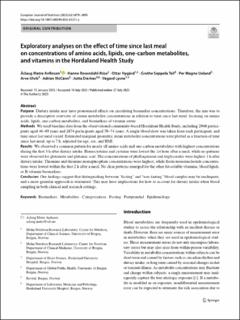| dc.contributor.author | Anfinsen, Åslaug Matre | |
| dc.contributor.author | Rosendahl-Riise, Hanne | |
| dc.contributor.author | Nygård, Ottar Kjell | |
| dc.contributor.author | Tell, Grethe S. | |
| dc.contributor.author | Ueland, Per Magne | |
| dc.contributor.author | Ulvik, Arve | |
| dc.contributor.author | McCann, Adrian | |
| dc.contributor.author | Dierkes, Jutta | |
| dc.contributor.author | Lysne, Vegard | |
| dc.date.accessioned | 2023-10-20T12:07:08Z | |
| dc.date.available | 2023-10-20T12:07:08Z | |
| dc.date.created | 2023-09-25T13:24:03Z | |
| dc.date.issued | 2023 | |
| dc.identifier.issn | 1436-6207 | |
| dc.identifier.uri | https://hdl.handle.net/11250/3097818 | |
| dc.description.abstract | Purpose
Dietary intake may have pronounced effects on circulating biomarker concentrations. Therefore, the aim was to provide a descriptive overview of serum metabolite concentrations in relation to time since last meal, focusing on amino acids, lipids, one-carbon metabolites, and biomarkers of vitamin status.
Methods
We used baseline data from the observational community-based Hordaland Health Study, including 2960 participants aged 46–49 years and 2874 participants aged 70–74 years. A single blood draw was taken from each participant, and time since last meal varied. Estimated marginal geometric mean metabolite concentrations were plotted as a function of time since last meal, up to 7 h, adjusted for age, sex, and BMI.
Results
We observed a common pattern for nearly all amino acids and one-carbon metabolites with highest concentrations during the first 3 h after dietary intake. Homocysteine and cysteine were lowest the 1st hour after a meal, while no patterns were observed for glutamate and glutamic acid. The concentrations of phylloquinone and triglycerides were highest 1 h after dietary intake. Thiamine and thiamine monophosphate concentrations were highest, while flavin mononucleotide concentrations were lowest within the first 2 h after a meal. No clear patterns emerged for the other fat-soluble vitamins, blood lipids, or B-vitamin biomarkers.
Conclusion
Our findings suggest that distinguishing between “fasting” and “non-fasting” blood samples may be inadequate, and a more granular approach is warranted. This may have implications for how to account for dietary intake when blood sampling in both clinical and research settings. | en_US |
| dc.language.iso | eng | en_US |
| dc.publisher | Springer | en_US |
| dc.rights | Navngivelse 4.0 Internasjonal | * |
| dc.rights.uri | http://creativecommons.org/licenses/by/4.0/deed.no | * |
| dc.title | Exploratory analyses on the effect of time since last meal on concentrations of amino acids, lipids, one-carbon metabolites, and vitamins in the Hordaland Health Study | en_US |
| dc.type | Journal article | en_US |
| dc.type | Peer reviewed | en_US |
| dc.description.version | publishedVersion | en_US |
| dc.rights.holder | Copyright 2023 The Author(s) | en_US |
| cristin.ispublished | true | |
| cristin.fulltext | original | |
| cristin.qualitycode | 1 | |
| dc.identifier.doi | 10.1007/s00394-023-03211-y | |
| dc.identifier.cristin | 2178588 | |
| dc.source.journal | European Journal of Nutrition | en_US |
| dc.source.pagenumber | 3079-3095 | en_US |
| dc.identifier.citation | European Journal of Nutrition. 2023, 62 (7), 3079-3095. | en_US |
| dc.source.volume | 62 | en_US |
| dc.source.issue | 7 | en_US |

